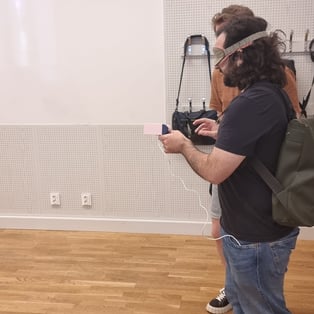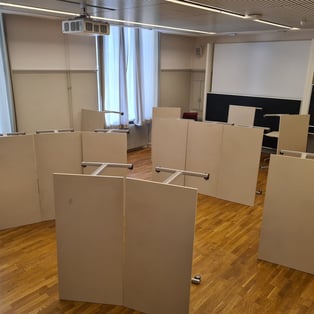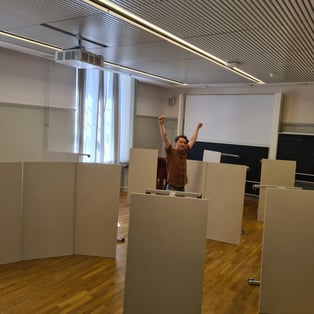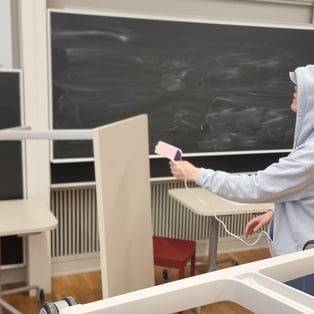The Spatializer: Enhancing Spatial Awareness Through Haptic Innovation
KTHYEAR 1VIDEO
DH2670 Haptics, Tactile and Tangible Interaction
3 min read
PROJECT OVERVIEW
Developed a haptic feedback device aimed at enhancing spatial awareness for visually impaired persons (VIPs). The Spatializer uses ultrasonic sensing to detect obstacles and converts this information into intuitive vibration patterns, creating a new way to experience space through touch.
HOW IT WORKS
The device uses an ultrasonic sensor to detect obstacles in the user's path, and a vibration motor provides haptic feedback based on the proximity of these obstacles. When the device is powered on using a USB cable connected to a power bank, the ultrasonic sensor continuously emits ultrasonic waves and measures the time it takes for the echoes to return. When an obstacle is detected within 100 centimeters, the vibration motor is activated. The frequency of the vibrations increases as the distance to the obstacle decreases, providing a tactile cue to the user about the proximity of the obstacle. The following table describes the pulse frequency in relation to obstacle proximity.
If no obstacles are detected within 100 centimeters, the vibration motor remains off, indicating an unobstructed path. The continuous power supply from the power bank ensures that the device can operate reliably for extended periods without the need for frequent recharging or battery replacement.
THE SPATIALIZER
We created this device to detect obstacles practically and ergonomically. We were inspired by the Elegoo tutorial on the 3D-printed measure gun for the device's design and layout. Using Middla's 3D printing facility, we 3D printed the device's body, which consisted of multiple parts that fit together to encase the internal components securely. We chose the Arduino Nano Every as the microcontroller because of its compact size and sufficient processing power to handle sensor readings and control the vibration motor. A mini breadboard was used for easy assembly and prototyping, allowing for quick modifications and iterations. We selected an ultrasonic sensor for accurate distance measurements and a vibration motor to provide haptic feedback on the device’s handle, delivering timely feedback in the user’s palm.




KEY FINDINGS
The Spatializer showed potential for helping users navigate obstacle courses during testing. However, there are several issues that need to be addressed to integrate it seamlessly into everyday life. User feedback was mixed. While users recognized the potential benefits of the device, they had concerns about its functionality. Although it was effective in navigation and detecting frontal obstacles, users often questioned its reliability, especially with angled obstacles, which affected their confidence. Some users even resorted to using their hands for confirmation, indicating a lack of trust in the device's feedback accuracy. Additionally, the ergonomic design posed some challenges, with users reporting discomfort in the handle ergonomics, orientation awareness, and one instance of sweaty hands. The idle state of the device when further than 100 cm from an obstacle made users uncertain of its functionality. Improvements could be made so the device always informs the user of the system state, regardless of whether an obstacle is detected. These findings highlight opportunities for design and material enhancements
The feedback provided by the device was mainly used in a binary manner—either vibrating or not vibrating. Most users did not sense the increase in vibration to help gauge distance. Users found it difficult to judge the distance and direction of obstacles using the vibrations alone, especially in complex environments. They noted that the device was most useful when used in binary. The device's accuracy and responsiveness were also lacking, especially when users moved quickly. There was a delay between detecting an obstacle and receiving feedback, which sometimes resulted in collisions, contradicting the device's main purpose.
The findings of the study may have limited applicability due to the narrow participant demographics. To ensure that the results can be relevant to a wider audience, it is essential to include a more diverse group of participants. Moreover, the controlled testing environment may not fully replicate real-world conditions, potentially affecting the accuracy of the results in everyday settings. Using blindfolds on sighted participants for testing might not accurately capture the experiences of long-term VIPs, impeding the authenticity and applicability of the findings. The testing obstacle course may not encompass all the real-life challenges faced by VIPs, necessitating a broader range of testing scenarios to fully comprehend the device's capabilities and limitations. Moreover, the subjectivity and potential bias in user feedback could compromise the objectivity and generalizability of the results, highlighting the need for more objective measures in future testing protocols.
In summary, the Spatializer exhibits potential as an assistive tool for individuals with visual impairments. However, to fully realize this potential, there are several areas that require improvement. Enhancing the vibration feedback system with more diverse and precise patterns could better communicate the distance and direction of obstacles. The system state could be relayed to the user even in the idle state. Integration of audio cues could furnish a more comprehensive navigation aid, particularly in settings where tactile feedback alone may be insufficient. Redesigning the handle to accommodate diverse hand sizes and ensure comfortable use is also imperative. Improving the range and sensitivity of the ultrasonic sensor to effectively detect obstacles at various heights and angles is essential to ensure the device's reliability in all environments. Offering more effective initial training to help users grasp the device's functionality could reduce the learning curve and enhance initial efficiency and user satisfaction.
Gamal Sadek
🇪🇬 3X Founder — 🚀 13yrs of Entrepreneurship — 📱 11yrs of Product — 🤵🏻♂️ 9yrs of Marriage — 👨🏻🍼 6yrs of Fatherhood — 🇸🇪 MSc.
